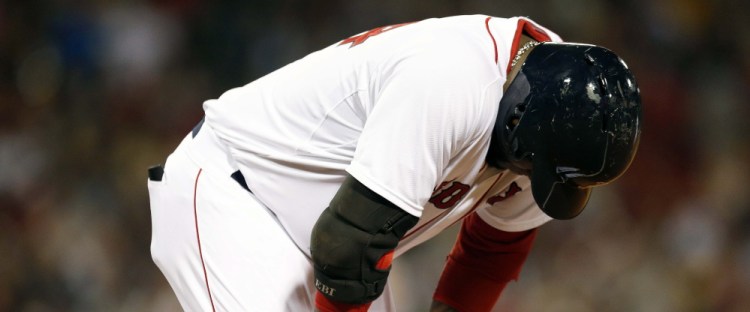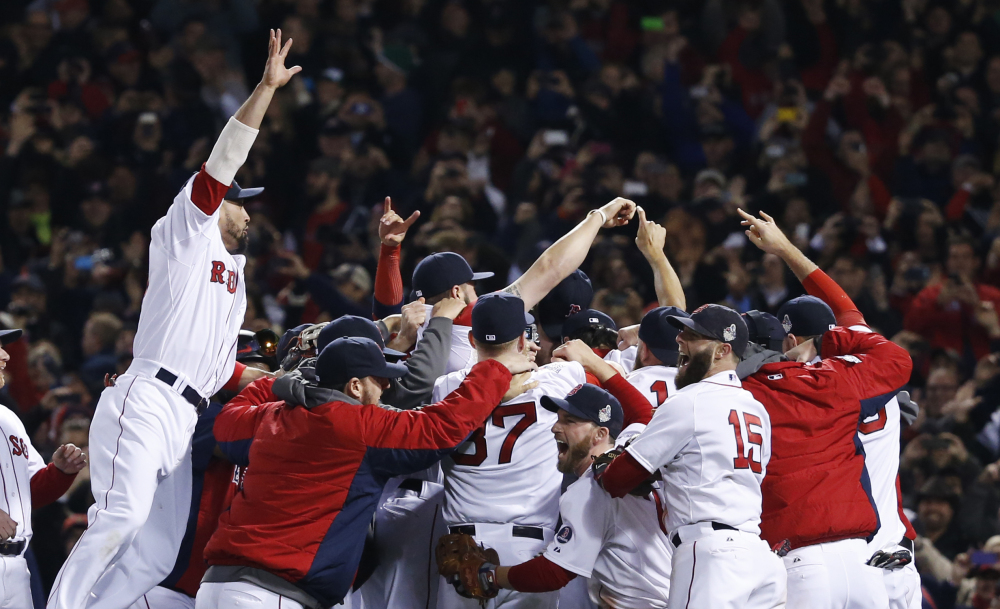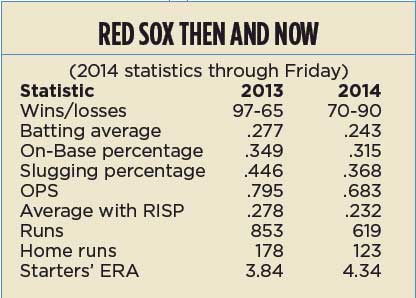When the Boston Red Sox lost their opening game of the 2014 season, it seemed just a case of bad luck. Boston lost 2-1 in Baltimore, even though Jon Lester pitched well and the Red Sox outhit the Orioles, 9-6.
Baltimore won with a Nelson Cruz home run. Boston left 12 men on and was 0 for 10 with runners in scoring position.
That certainly would turn around, right? This was, after all, the defending World Series champion, a team that figures out ways to win.
That opener was March 31.
Now, on Sept. 28, we know better. The team that went from worst-to-first is back to worst.
How did it happen?
Here are eight reasons, not necessarily ordered by importance. And, yes, many of these explanations are interdependent.
1. No clutch. Seattle is 12th in the American League in batting average (.244), slightly better than the Red Sox (.243). But the Mainers remained a playoff contender because they’re fifth in the league with runners in scoring position (.263).
Put runners on second base and/or third, and watch the Red Sox wilt. They are batting .232 with runners in scoring position – worst in the American League by a wide margin.
Last year Boston ranked second with RISP (.277).
2. No power. So many times this season we heard Manager John Farrell say, “We had opportunities …”
The Red Sox know how to get on base. Early in the season they were still among the best in the league in on-base percentage and even now rank eighth (.315). That’s better than the Orioles (.312)
But one of the barometers of offensive production is OPS – on-base percentage plus slugging percentage.
Slugging means doubles, triple, home runs.
Where do the Red Sox rank?
Next to last with a .368 mark.
The Orioles are second in the league in slugging percentage (.423).
Boston also has hit a lot fewer home runs than the Orioles (123 to 209).
The Red Sox didn’t re-sign Jarrod Saltalamacchia, Jacoby Ellsbury and (initially) Stephen Drew. They accounted for 36 homers last year. This season, with the exception of David Ortiz’s 35 home runs (up from 30 last year), the remaining Red Sox are hitting fewer bombs. Mike Napoli, Shane Victorino, Daniel Nava, Will Middlebrooks and Jonny Gomes combined for 80 homers last year and 31 in 2014.
3. No Shane Victorino. He played only 30 games because of injuries, including a back issue that required season-ending surgery. His absence was huge. Last year he brought energy to the clubhouse, superb defense to right field and an .802 OPS, as well as a .315 average with runners in scoring position.
4. No rookie production. Infielder Xander Bogaerts showed such poise in the 2013 postseason. Jackie Bradley Jr. is the best defensive center fielder in the league. Will Middlebrooks can hit the ball a mile.
None of that mattered. Farrell said it was rare that a defending champion would incorporate three rookies, although Middlebrooks technically has a year’s worth of experience.
All three failed. Bogaerts, 21, showed the most with a .304 batting average through two months, then encountered a horrific slump that saw those numbers drop to .221 by Aug. 30.
Bradley, the defensive whiz, didn’t have to be a batting champion to contribute, but he became a consistent rally-killer. His .198 average/.531 OPS and 121 strikeouts in 384 at-bats clearly suggest he isn’t ready for the big leagues.
Boston signed Grady Sizemore for insurance in center, but that didn’t work out and Sizemore (.216) was released.
Middlebrooks was the delight of 2012 with an .835 OPS over a three-month period of time. But that now is looking like an aberration rather than the norm. Since then he’s either been injured or overmatched often. He batted .227 in 2013 with 17 home runs, and the slide grew even steeper this year (.191/two home runs).
When Middlebrooks hit the disabled list in mid-May, the Red Sox brought in Drew. His .176 average/.583 OPS hardly helped the cause.
5. Not enough veterans carrying the load. Sometimes you can hide rookies in a lineup if the veterans are coming through. They didn’t. Dustin Pedroia, Napoli, Nava and even Ortiz saw a drop in OPS.
Pedroia gutted out 2013 with a hand/wrist injury (.301 average/.787 OPS). He fought the pain again in 2014 but less effectively (.278/.712).
Napoli’s production is vital because he bats behind Ortiz. If Napoli isn’t a threat, then teams pitch around Ortiz.
Napoli hit .259 last year but with 23 home runs and a .482 slugging percentage. This year: .248, 17 homers, .419 slugging percentage.
Nava began in such a slump he was sent to Pawtucket. His OPS has climbed to .704 but not near his .831 career mark last season.
Ortiz is hitting more home runs but his OPS has dropped from .959 to .873. Still impressive but he had no supporting cast.
6. No heart behind the plate. The Red Sox filled the void of Saltalamacchia by signing combustible free agent A.J. Pierzynski. His reputation as a me-first, free-swinging, below-average catcher seemed to go against the Red Sox’s belief in a strong presence behind the plate.
For example, when the personable David Ross caught a pitcher who had a bad day, Ross often protected his guy, even taking some of the blame for the poor outing.
When Pierzynski was approached after a rough game and questioned about a pitcher he caught, he often responded, “ask him.”
Pierzynski just didn’t fit in, and his .254 average/.633 OPS didn’t make up for the negatives. He was released July 9.
Saltalamacchia staying may not have been the answer. Now with the Marlins, he’s batting .221 (.685 OPS). And Ross may be a fine receiver but his production (.187/.637) is down.
7. No consistent rotation. Boston began with Jon Lester and John Lackey. A good 1-2. And Jake Peavy figured to keep Boston in games provided the Red Sox hit.
The hope was that Clay Buchholz was healthy after last year’s injury and Felix Doubront would ride the mojo from an impressive postseason bullpen role. Plus there was Brandon Workman ready to fill in.
Buchholz was horrible early and inconsistent since, his ERA down to 5.31.
Doubront was maddening to watch because his production (6.07 ERA) never matched his promise. He was traded to the Cubs.
Workman hasn’t been the answer: 5.36 ERA in 15 starts.
8. No magic. Everything seemed to work for Boston last year. Role players delivered when needed. Outfielder Jonny Gomes batted .247 last season but was .346 with runners in scoring position. Utility player Mike Carp led the league in pinch-hit RBI (nine). He batted .296 with a .333 average with RISP.
This year Gomes batted .234 for Boston (.265 with RISP). He was traded. Carp hit .198 (.200 with RISP). He was released at his request.
So there you have it, a blueprint for last place: Players producing less as a whole, especially in clutch situations, with less power. While veterans struggled, new players didn’t fill the gaps but actually created bigger holes.
Even the touted starting rotations couldn’t be consistent.
Very little worked for the Red Sox and thus there they sit at the bottom of the American League East, having fallen so fast from the top.
Send questions/comments to the editors.







Success. Please wait for the page to reload. If the page does not reload within 5 seconds, please refresh the page.
Enter your email and password to access comments.
Hi, to comment on stories you must . This profile is in addition to your subscription and website login.
Already have a commenting profile? .
Invalid username/password.
Please check your email to confirm and complete your registration.
Only subscribers are eligible to post comments. Please subscribe or login first for digital access. Here’s why.
Use the form below to reset your password. When you've submitted your account email, we will send an email with a reset code.